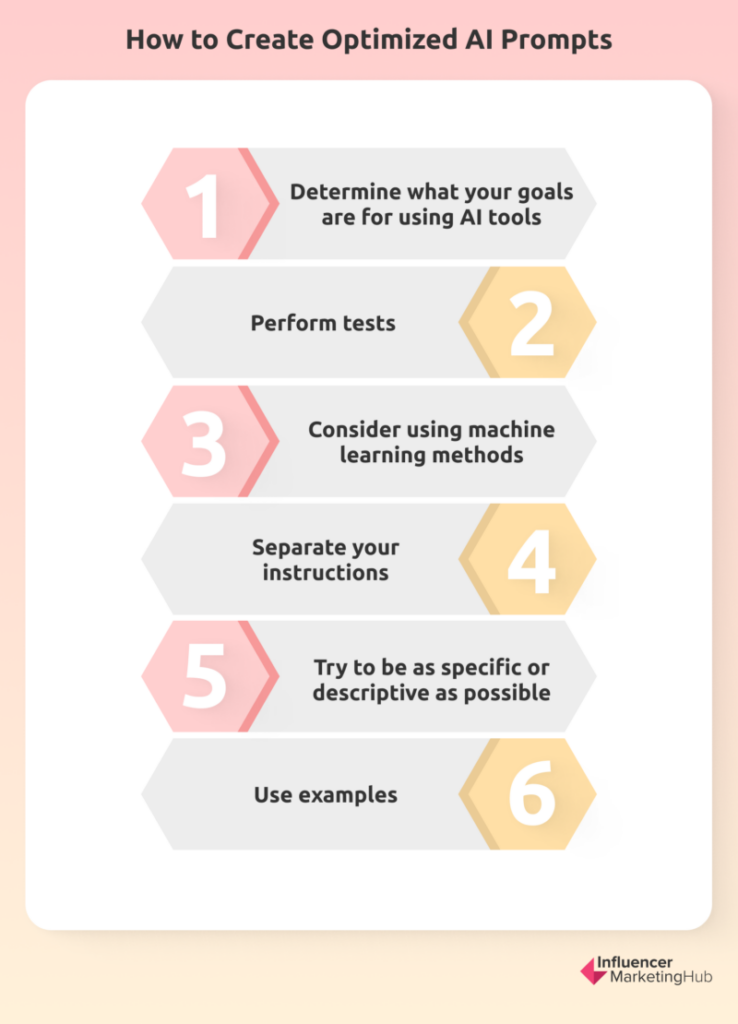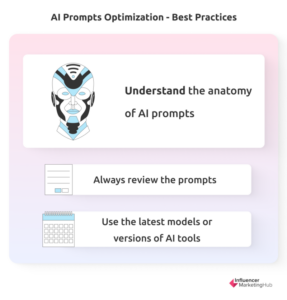Natural language processing tools and art generators powered by artificial intelligence, such as ChatGPT and DALL-E2, are taking the world by storm.
These machine learning models, driven by carefully crafted prompts, produce impressive outcomes ranging from search-optimized content to stunning visual art.
The surge in AI marketing tools is ushering in a new era of opportunity for creators and businesses alike, showcasing the potential to generate AI-driven content, optimize campaigns, and personalize outputs through prompt engineering.
Notably, the AI suite has proven its impact by increasing conversions by 10% and reducing hold time violations by 60%, highlighting its effectiveness in practical applications.
AI is already making strides in areas like influencer marketing, addressing challenges such as fraud detection and campaign performance analysis.
In this article, we’ll explore AI prompts and how to optimize them for the best results.
What Are AI Prompts?
Simply put, prompting is how a user communicates with an AI tools. With prompts, you can “tell” the AI what you want and how you want it to be done. Through a prompt, you’re basically describing what you want to see as a result.
For example, if you want to create an image but don’t have a picture to use as a reference—you can tell the AI that you want the image to look a certain way. Think of it as describing a picture to an artist who can recreate your idea into an actual image. When describing the image that you want to get from the artist, you’ll likely be using clear and specific descriptions. The same principle applies to AI tools like DALL-E2 and ChatGPT.
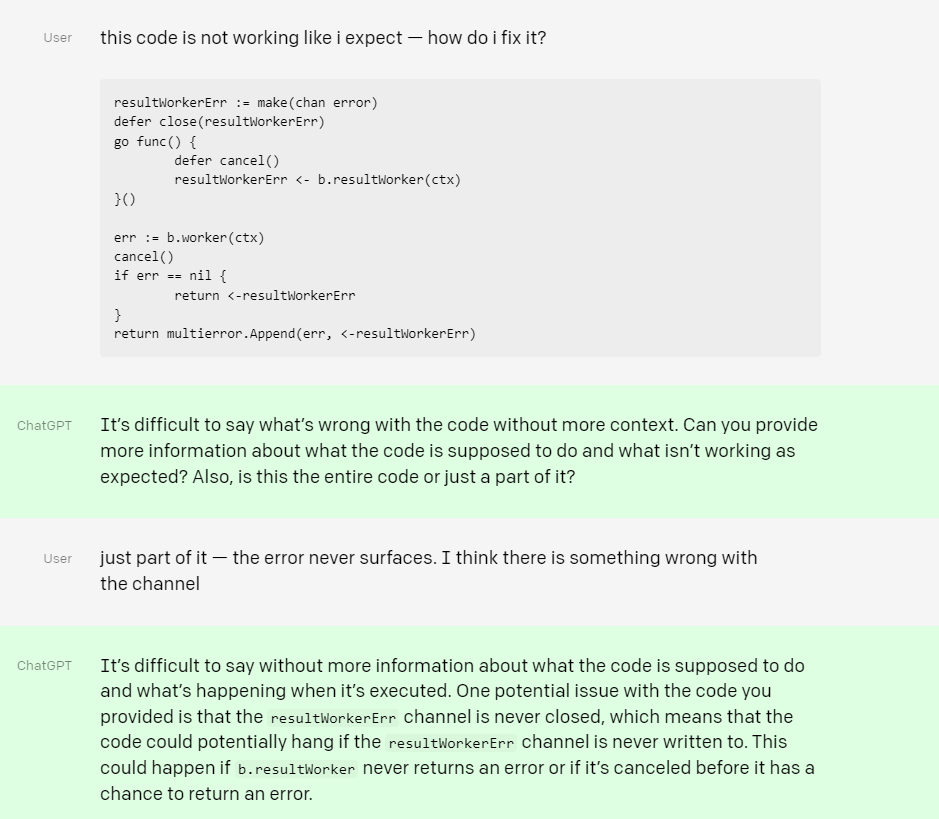
Source: openai.com
It’s worth noting that while these AI tools are capable of understanding and processing language, they have a different way of understanding what a user is trying to say. This is where prompt engineering comes in.
AI prompts can be divided into two categories: text prompting and image prompting.
In text prompting, you’re “talking” to a natural language processor like ChatGPT. If you input a general query, such as “how do you bake bread”, you’ll likely get a general answer. If you enter a more specific query or statement, such as “explain how to bake bread in simple terms”, then you’ll likely end up with a more detailed result.
Note that when using a natural language processing tool, you may get answers that are incorrect or nonsensical. Also, it may take several tries or using different phrasing for the same prompt to arrive at the result that you want.
In image prompting, which is used for AI image generators or text-to-image models like DALL-E2 and Stable Diffusion, you’re using words to describe the image that you want to create.
For instance, when you use a prompt like “a cabin in the woods”, you’ll likely get just that. However, if you change the descriptors or use more specific terms, such as “a large cabin in the dark woods”, the image changes accordingly and you’ll get more optimal, specific results.
What Is AI Prompt Engineering?
In prompt engineering, the user is leveraging the right prompts so that the AI tool is capable of generating the best possible results. A prompt engineer is responsible for “translating” your concept or idea into terms that the AI tool can understand.
AI prompts, which are essentially commands that the AI model can understand, can take on various forms. They can be a string of codes, a complete statement, or even just a few words. Through prompting, you’re “teaching” the AI model to create specific results. Think of it like using writing prompts to help you jumpstart a writing or art assignment.
Aside from statements or instructions, prompts can also be in the form of a question, examples, or even data.
With AI prompt engineering, you’re designing or creating prompts to train AI models for a specific task, such as coming up with a joke or giving you step-by-step instructions on how to bake a cake. Furthermore, you’re training the AI model, helping it make more accurate results. Additionally, prompt engineering enables AI systems to become more user-friendly. That’s because prompt engineering helps these systems better understand a user’s request, which is often written in natural or plain language, and what results the user is expecting from it.
Thus, you’re training the AI system to be easier to use and come up with outputs that can be tailored to fit different use cases.
For example, a prompt like “tell me a joke” will likely get varied or even open-ended results, but when you use optimized AI prompts, particularly ones that leverage thought progression, you’ll be more likely to get better results.
By leveraging prompt engineering, you’d be able to save a lot of time and effort. For example, instead of manually analyzing data or searching for keywords, you can use AI prompts to automate such tasks. You can also use AI prompts to generate new ideas for your next project.
For example, writers can use AI prompts to create more optimized content. Some of the most common challenges that writers are facing include creating great titles and writing long-form text. An AI tool, provided that you’re using the right prompts, can help you generate unique and search-optimized titles. For instance, you can ask the AI tool to create a headline with the keywords “cake” and “holidays”. If you want to have more specific titles, supplement the prompt with more information.
In the case of long-form content, you can use prompt engineering to generate ideas or the first few paragraphs of your assignment. For example, if you already have a title, just further optimize your AI prompt by including relevant information, such as the topic of the article, the intended audience, and the article’s tone.
Common Challenges in AI Prompt Engineering
Prompt engineering may sound relatively simple, but it does come with its fair share of challenges. For one, a user would need to create prompts that are accurate and natural-sounding. Creating a very specific prompt may result in overly specific results, while creating general prompts may give you results that aren’t that accurate.
Furthermore, your prompts should be understood by humans, given that you’re after results that can be utilized in the real world.
Another challenge in prompt engineering is finding the right input data. The type and quality of your input data, such as text or images, will play a major role in what kind of output the AI model will be able to generate.
Also, AI models aren’t immune to inconsistencies. Despite incorporating all the necessary information in your prompt, you may either get a sound output or a completely nonsensical result. This is one of the risks when using emerging technologies. It’s also possible for AI tools to fabricate concepts, which is why it’s crucial that you set your prompts to only the necessary parameters.
However, through prompt engineering, you may be able to minimize the risk of getting vague, biased, or unreliable results.
How to Optimize AI Prompts
Being able to write optimized AI prompts will allow you to get the results that you’re looking for. While you can use UI tools to get the job done, knowing how to write optimized AI prompts is a valuable and useful skill.
Yes, you can still get impressive results even without prompt engineering but chances are, you won’t be getting the exact results that you want. That’s why it’s important to know how to optimize your AI prompts. Furthermore, knowing how to engineer prompts allows you to get more consistent results, while also letting you improve the results.
It’s vital for users to understand how AI responds to and processes your prompts. Here are some tips to help you create optimized AI prompts.
-
Determine what your goals are for using AI tools
Knowing what your goals are, allows you to be more specific when writing your prompts. What do you want to achieve with your AI-generated content? Do you want to use it to create unique titles or do you want to use it to create content faster? Aside from identifying your goals, you also need to have a way to measure the results. This way, you’d be able to gauge its performance and see which areas are working well or which ones you need to improve on.
-
Perform tests
Tests like A/B testing allow you to determine which prompts work the best. Through split testing, you’re able to measure the performance of each prompt, allowing you to find out which ones are more effective in generating the results you want.
-
Consider using machine learning methods and NLP techniques
Machine learning methods, such as unsupervised learning and reinforcement learning, let you train AI models using different prompts. For example, by using the reinforcement learning methods, you’re equipping the AI system to learn from interactions. Like A/B testing, machine learning methods allow you to use different prompts to train the models and assess their performance.
Meanwhile, using NLP techniques can help AI systems better understand and analyze the plain language that a user uses and identify emerging patterns or trends that can be used so that you can come up with more optimized AI prompts.
-
Separate your instructions
If you’re using a text-to-text AI tool, write your input in a particular way to make the prompt more effective. Let’s use ChatGPT as an example.
Instead of writing “[your prompt] + [example text]”, you need to write your prompts like this: “[your prompt] + text: “”” [text input]’’’.
Using ### or ‘””” helps break down your prompt into distinct sections: the instruction and the context. To give you a better idea of how this will look like, check out the image below.
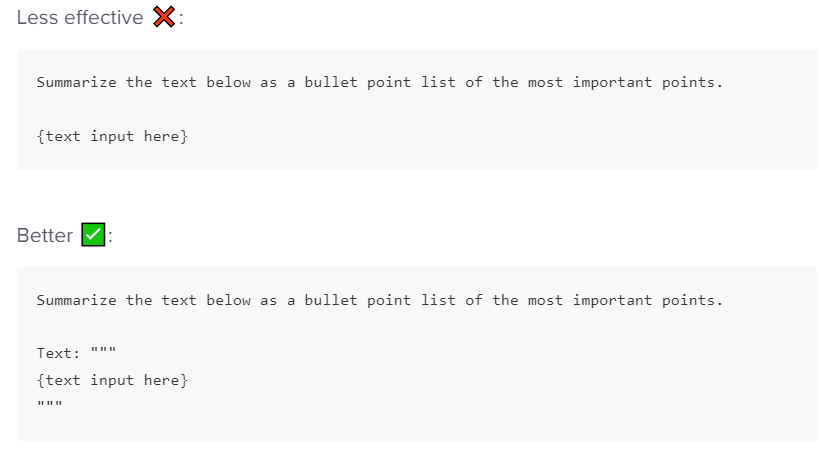
Source: help.openai.com
-
Try to be as specific or descriptive as possible
One of the most important things to keep in mind when trying to create optimized AI prompts is that it should ideally be detailed, descriptive, and specific.
For example, instead of keying in “Write an essay about capitalism”, you can create a more specific prompt that contains key information, such as the context, format, and style that the result should have. So, you can write down something like “Write a 500-word essay about capitalism, focusing on its effects, in the style of Allen Ginsberg”. Avoid using fluff and incorporating vague or imprecise prompts.
-
Use examples
AI models are better able to respond with more accurate results when you provide them with examples. For instance, if you have a specific format in mind, you can add that to your prompt instead of just going with a general statement that describes the kind of output you’re expecting.
Take a look at the example below to see how you can better leverage examples.
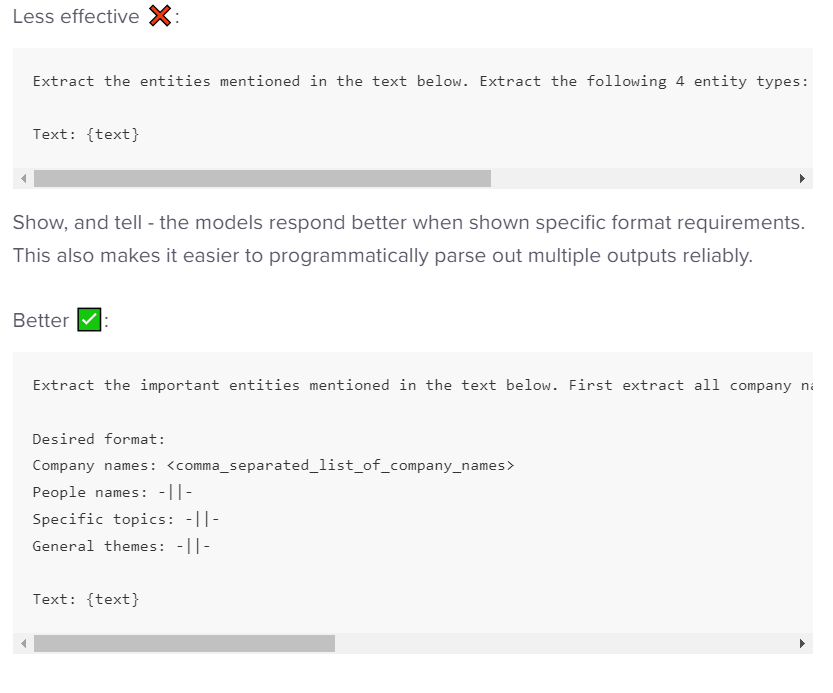
Source: help.openai.com
Best Practices for Optimizing AI Prompts
-
Understand the anatomy of AI prompts
Knowing the anatomy of a prompt can help you come up with optimized AI prompts. According to creative technologist Paul DelSignore, if you’re using an AI image generator, a prompt can be broken down into four components: content type, description, style, and composition.
Determining the content type, such as a drawing or sketch, helps the tool focus on what you want to achieve. Adding specific descriptions, what type of art style you want to use, and details about its composition, such as Art Deco or Abstract or specific resolutions, can help finetune the results.
For example, a prompt like “A drawing of a bear in the woods” will yield a different result compared to a prompt like “A drawing of a happy bear in a sunshine-filled forest, digital art”.
-
Always review the prompts
Users should keep in mind that using AI tools can be a hit or miss. Test out different prompts and modify descriptions until you get the results you want. Aside from reviewing and comparing prompts, you also need to check the results to see if they fit your requirements.
While testing and reviewing prompts can be time-consuming, this helps ensure that you will get the best results with your AI tool.
-
Use the latest models or versions of AI tools
To get the best results, you may want to consider using the latest version or model of an AI tool. in the case of ChatGPT, for example, the developers recommend using the “text-davinci-003” model for generating texts and the “code-davinci-002” for generating codes.
Comparison of AI Prompt Optimization Features
Tool | Primary Use | AI Model | Prompt Optimization Features | User Control | Ease of Use | Customization |
ChatGPT | Text Generation | GPT-4 | Offers flexible prompts with contextual adjustments. | High - Manual tweaking | User-friendly | Highly customizable |
Jasper | Copywriting, Marketing | GPT-3 | Optimized for marketing copy, SEO, and ad prompts. | Moderate - AI-guided | User-friendly | Customizable with templates |
Chinchilla | Research, Text Generation | Custom | Focuses on detailed prompt refinement for research purposes. | High - Precision focused | Moderate | Moderate |
Notion AI | Productivity, Note-taking | GPT-3 | Integrates with note-taking, streamlines prompt inputs. | Moderate - Integrated AI | Highly user-friendly | Limited customization |
Chai | Conversational AI | GPT-3 | Tailored for chatbot and conversational contexts. | High - Dialogue-specific | User-friendly | Moderately customizable |
GPT-3 DALL-E2 | Image Generation | GPT-3 + DALL-E2 | Detailed prompt customization for generating images. | High - Complex prompts | User-friendly | Highly customizable |
Stable Diffusion | Image Generation | Custom | Offers extensive control over image generation prompts. | High - Creative freedom | Moderate (Tech-savvy) | Highly customizable |
Midjourney | Art and Design | Custom | Specializes in artistic prompts with unique style control. | High - Artist-oriented | Moderate | Highly customizable |
Craiyon | Image Generation (Basic) | Custom (DALL-E mini) | Simplified prompt entry for quick image generation. | Low - Basic prompts | Highly user-friendly | Limited customization |
NightCafe | Art and Design | Custom | Supports creative prompts for various artistic styles. | High - Artist-oriented | Moderate | Highly customizable |
Key Insights:
- User Control: Tools like ChatGPT, Stable Diffusion, and Midjourney offer extensive control over prompt customization, making them suitable for users who need detailed and precise outputs.
- Ease of Use: Notion AI, Jasper, and Craiyon are highly user-friendly, designed for users who prefer a simpler, more guided approach to prompt creation.
- Customization: GPT-3 DALL-E2, Midjourney, and Stable Diffusion provide advanced customization options, especially for creative projects requiring specific styles or outputs.
Frequently Asked Questions
How do you manually optimize AI prompts?
To manually optimize AI prompts, start by clearly defining your objective and identifying key terms that should be included in the response. Break down complex instructions into simpler steps and avoid ambiguous language. Experiment with different phrasing, and use examples or specific scenarios to guide the AI’s focus. Iterative testing and refinement are key—observe the AI's output and continuously adjust the prompt until the desired quality is achieved.
What text-to-image AI tools can I use?
Popular text-to-image AI image generators include:
- DALL-E2
- Stable Diffusion
- Midjourney
- Craiyon (formerly DALL-E mini)
- NightCafe
What are some of the most popular text-to-text AI tools?
Some of the popular text-to-text AI tools being used today include:
- ChatGPT
- Jasper
- Chinchilla
- Notion AI
- Chai
- GPT-3
What do I need to consider when writing optimized AI prompts?
Aside from being specific and descriptive, as well as providing relevant examples, you also need to consider the complexity of the task. You also need to keep in mind your intended audience. The great thing about these AI tools is that most of them can be accessed for free. Thus, you can try to practice writing AI prompts until you get the hang of it and are able to create detailed and engaging prompts that will yield your desired results.
What are the benefits of using AI prompt optimization tools?
AI prompt optimization tools, such as PromptPerfect or Promptimizer, automate the process of refining prompts, saving time and increasing efficiency. These tools often employ machine learning techniques and algorithms to suggest improvements, ensuring that prompts are structured to elicit the best possible responses from AI models. The result is higher accuracy, creativity, and relevance in AI-generated content, which is particularly valuable in professional and high-stakes applications.
